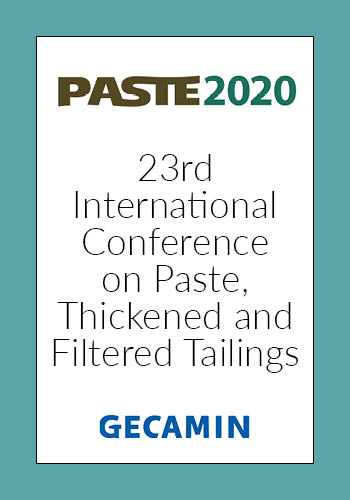Tailings Geotechnical Characterization from Cuiabá Mine to Support a Dry Stacking Disposal Design in Cuiabá Dam

|
Authors: Zorzal, R; Mansur Gomes, M; Pinheiro, J |
DOI https://doi.org/10.36487/ACG_repo/2052_55
Cite As:
Zorzal, R, Mansur Gomes, M & Pinheiro, J 2020, 'Tailings Geotechnical Characterization from Cuiabá Mine to Support a Dry Stacking Disposal Design in Cuiabá Dam', in H Quelopana (ed.), Paste 2020: 23rd International Conference on Paste, Thickened and Filtered Tailings, Gecamin Publications, Santiago, https://doi.org/10.36487/ACG_repo/2052_55
Abstract:
The main advantages of Filtered Tailings (FT) are related to water reduction in tailings disposal when compared with other methods, once it allows the geomaterial to be disposed close to optimum water content, thus allowing a better tailings compaction, and consequently increasing tailings shear strength for both drained and undrained conditions. Another advantage is the significant amount of water recovery during ore beneficiation process, especially in mining projects in dry areas. However, as the main FT disposal designs in operation worldwide are located in drier regions, this Tailings Storage Facility (TSF) method may be a challenge for tropical regions as they generally present a positive water balance. As a consequence, tailings can be saturated and present contractive behaviour if the disposal has not been made properly and compaction has not been well controlled. Thus, this paper presents the geotechnical characterization of tailings generated in Cuiabá Mine Site to support the applicability of FT technique in dry stacking design (compacted FT disposal for buttressing downstream of the dam embankment and across the tailings reservoir). It included seismic piezocone – SCPTU tests of tailings disposed in the reservoir and laboratory tests with disturbed tailings samples at different void ratios to evaluate the effect of compaction effort on the geotechnical parameters of FT to support this new TSF method. The main results obtained from the geotechnical tests to support the design have shown: (i) tailings inside the existing TSF have presented contractive behaviour under high strain conditions and undrained strength ratio of 0.21; (ii) the denser the tailings, the higher the undrained strength ratio and the total friction angle. Besides, the contractive or quasi-steady state behaviour obtained to higher void ratios changed to quasi-steady state or strain-hardening behaviour with density increase; and (iii) the tailings critical state friction angle was closed to 32º.
References:
Brandon, T.L.; Rose, A.T.; Duncan, J.M. (2006) ‘Drained and Undrained Strength Interpretation for Low-Plasticity Silts’, Journal of Geotechnical and Geoenvironmental Engineering – ASCE, Volume 132, nº 2, 250-257.
Budhu, M. (2011) Soil Mechanics and Foundation, 3rd Edition, John Wiley & Sons, INC., United States of America – USA.
Contreras, I.; Zwissler, B. (2017) ‘Yield Shear Strength Ratio for Liquefaction Triggering Analysis of Tailings Dams’, Tailings and Mine Waste 2017 – Proceedings of the 23nd International Conference on Tailings and Mine Waste, 5-8 November 2017, Banff, Alberta, Canada, University of Alberta, Department of Civil & Environmental Engineering, Canada, 552-561.
Crystal, C.; Hore, C.; Ezama, I. (2018) ‘Filter-Pressed Dry Stacking: Design Considerations Based on Practical Experience’, Tailings and Mine Waste 2018 – Proceedings of the 24th International Conference on Tailings and Mine Waste, 30 Sep.-Oct. 2 2018, Keystone Resort, Colorado State University, Keystone, Colorado, USA, UBS Studios – University of British Columbia, Vancouver BC, Canada, 209-219.
Gomes, M.F.M.; Filho, J.G.M.; Pinheiro, J.A.; Crystal, C. (2019) ‘Disposal of tailings and the mining industry perspective: a case study of the Cuiabá Mine’, Paste 2019 – Proceedings of the 22nd International Conference on Paste, Thickened and Filtered Tailings, 8-10 May 2019, The Westin, Cape Town, South Africa, ACG – Australian Centre for Geomechanics, Perth, Australia, 217-230.
Jefferies, M.; Been, K. (2016) Soil Liquefaction – A Critical State Approach, 2nd Edition, CRC Press – Taylor & Francis Group, New York, USA.
Jewell, R.J.; Fourie, A. (2015) Paste and Thickened Tailings – A Guide, 3rd Edition, ACG – Australian Centre for Geomechanics, Western Australia, Australia.
Lara, J.L.; León, E. (2011) ‘Design and Operational Experience of the Cerro Lindo Filtered Tailings Deposit’, Paste 2011 – Proceedings of the 14th International Seminar on Paste and Thickened Tailings, 5-7 April 2011, Perth, Australia, ACG – Australian Centre for Geomechanics, Perth, Australia, 25-28.
Olson, S.M.; Stark, T.D. (2003) ‘Yield Strength Ratio and Liquefaction Analysis of Slopes and Embankments’, Journal of Geotechnical and Geoenvironmental Engineering – ASCE, Volume 129, nº 8, 727-737.
Robertson, P.K. (2010) ‘Evaluation of Flow Liquefaction and Liquefied Strength Using the Cone Penetration Test’, Journal of Geotechnical and Geoenvironmental Engineering – ASCE, Volume 136, nº 6, 842-853.
Robertson, P.K. (2016) ‘Cone penetration test (CPT)-based soil behaviour type (SBT) classification system — an update’, Canadian Geotechnical Journal, 53(12), 1910-1927.
Robertson, P.K.; Wride, C.E. (1998) ‘Evaluating cyclic liquefaction potential using the cone penetration test’, Canadian Geotechnical Journal, 35(3), 442-459.
Sadrekarimi, A. (2014) ‘Effect of the Mode of Shear on Static Liquefaction Analysis’, Journal of Geotechnical and Geoenvironmental Engineering – ASCE, Volume 140, nº 12, 04014069.
Schnaid, F. (2009) In Situ Testing in Geomechanics – The Main Tests, 1st Edition, Taylor & Francis, Oxford, England.
Watson, A.H.; Corser, P.G.; Garces Pardo, E.E.; Lopez Christian, T.E.; Vandekeybus, J. (2010) ‘A Comparison of Alternative Tailings Disposal Methods – The Promises and Realities’, Mine Waste 2010 – Proceedings of the First International Seminar on the Reduction of Risk in the Management of Tailings and Mine Waste, 29 September – 1 October 2010, Perth, Australia, ACG – Australian Centre for Geomechanics, Perth, Australia, 499-514.
© Copyright 2025, Australian Centre for Geomechanics (ACG), The University of Western Australia. All rights reserved.
View copyright/legal information
Please direct any queries or error reports to repository-acg@uwa.edu.au
View copyright/legal information
Please direct any queries or error reports to repository-acg@uwa.edu.au